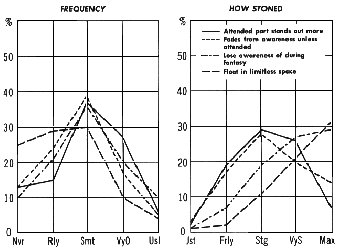
Note.—For guide to interpreting the "How Stoned" graph,
see note on Figure 6-1.

 |
| Figure 11-1. AWARENESS OF ONE'S OWN BODY Note.—For guide to interpreting the "How Stoned" graph, see note on Figure 6-1. |
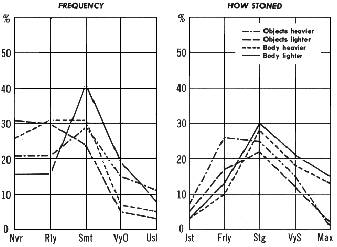 |
| Figure 11-2. PERCEIVED WEIGHTS Note.—For guide to interpreting the "How Stoned" graph, see note on Figure 6-1. |
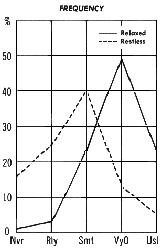 |
| Figure 11-3. DESIRE FOR MOVEMENT |
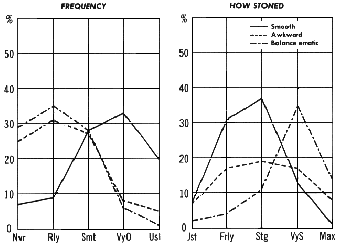 |
| Figure 11-4. QUALITY OF MOVEMENT Note.—For guide to interpreting the "How Stoned" graph, see note on Figure 6-1. |
I occasionally try various Yoga breathing and meditation exercises when I'm stoned. Several times I've tried one of inhaling slowly and deeply, picturing a flow of energy coming in with my breath and going right on down to the base of my spine. I hold my breath for half a minute to a minute, all the time picturing an accumulation of energy in the root chakra at the base of the spine. As I slowly exhale I picture this energy as flowing up my spine, all the way up to my brain. The several times I've done this have convinced me that prana is real and powerful enough so I've decided to stop fooling around with it. The first few breaths I'm picturing, imagining all this, but then it becomes real and I can feel the energy, the prana, flowing up my spine. My consciousness is changed in distinct jumps as it goes up my spine; and by the time the prana flows into my head, there is a very distinct jump, and I'm suddenly more stoned, and 25 percent more stoned than I usually am for smoking whatever quantity of grass I've had. I'll stay more stoned as long as I keep up the exercise, but drift back down in a minute or two after I stop. I can't really describe the nature of the particular sorts of consciousness I experience as the energy jumps up along the spinal cord....
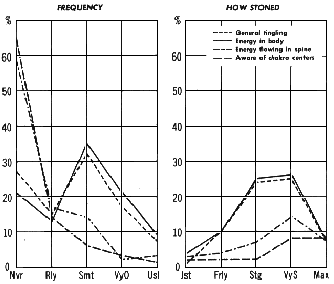 |
| Figure 11-5. PERCEPTION OF PSYCHICAL ENERGY Note.—For guide to interpreting the "How Stoned" graph, see note on Figure 6-1. |
| Just | Fairly | Strongly | Very Strongly | Maximum | |||||
| |||||||||
| Vomit | |||||||||
| Float in space | |||||||||
| Feel nauseated | |||||||||
| LOSE ALL CSS OF BODY DURING FANTASY | |||||||||
| Aware of chakras | |||||||||
| BODY GETS NUMB | |||||||||
| FELT FORM DIFFERENT FROM ACTUAL BODY SHAPE | |||||||||
| Feel energy in spine | |||||||||
| MORE AWARE OF INTERNAL ORGANS GENERALLY | |||||||||
| MUSCLE TREMOR | |||||||||
| CHANGE IN LOCATION OF CONSCIOUSNESS | |||||||||
| VIBRATION IN BODY THAT IS NOT MUSCLE TREMOR | |||||||||
| AWARE INTERNAL ORGANS, URINATING | |||||||||
| BODY FEELS LARGER | |||||||||
| BODY FEELS SMALLER | |||||||||
| FEEL ENERGY, POWER FLOW IN BODY | |||||||||
| BODY PART ATTENDED TO STANDS OUT MORE | |||||||||
| SENSE OF BALANCE ERRATIC | |||||||||
| BODY SEEMS VERY LIGHT, FLOATING | |||||||||
| BODY SEEMS VERY HEAVY | |||||||||
| LOSE AWARENESS OF BODY UNLESS STIMULATED | |||||||||
| VERY AWARE OF BREATHING | |||||||||
| MOVEMENTS AWKWARD, UNCOORDINATED | |||||||||
| FEEL WEAKER | |||||||||
| AWARE OF HEART BEATING | |||||||||
| FEEL STRONGER | |||||||||
| LESS AWARE OF BODY TENSIONS IN EMOTION | |||||||||
| PAIN EASIER TO TOLERATE IF ATTENTION DIVERTED | |||||||||
| SEXUAL ORGASM HAS NEW, PLEASURABLE QUALITIES | |||||||||
| OBJECTS SEEM LIGHTER | |||||||||
| MORE AWARE OF BODY TENSIONS IN EMOTION | |||||||||
| SURFACES FEEL ROUGHER, FORM PATTERNS | |||||||||
| PLEASANT WARMTH THROUGHOUT BODY | |||||||||
| PAIN MORE INTENSE IF CONCENTRATED ON | |||||||||
| OBJECTS SEEM HEAVIER | |||||||||
| NEW QUALITIES TO TOUCH | |||||||||
| SURFACES SEEM SMOOTHER, SILKIER | |||||||||
| MOVEMENTS EXCEPTIONALLY SMOOTH | |||||||||
| GET PHYSICALLY RELAXED, DON'T WANT TO MOVE | |||||||||
| TOUCH MORE EXCITING | |||||||||
| GET PHYSICLLY RESTLESS | |||||||||
| Just | Fairly | Strongly | Very Strongly | Maximum | |||||
| BACKGROUND FACTORS | EFFECTS | |
|---|---|---|
| More Drug Experience | More frequent: Body feels smaller Feel stronger Aware of internal organs when defecating Feel energy in spine Aware of chakra centers Movements awkward Feelings of energy in body | Less frequent: Lose awareness of body parts not focused Pain more intense Movement exceptionally smooth, coordinated Lose consciousness of body in fantsy Less intoxicated for: Pain more intense |
| Older | More intoxicated for: Pain more intense | Less frequent: Pain more intense Body feels heavier Physically restless Less intoxicated for: Float in limitless space Lose awareness of body parts not focused on Balance erratic |
| More Educated | More intoxicated for: Movements awkward | Less frequent: Pain more intense Body feels light Body feels smaller Hyperaware of breathing Physically restless Less intoxicated for: Location of consciousness moves Aware of heart beating |
| Males | More frequent: Body feels numb More intoxicated for: More aware of internal organs Body feels numb Body feels smaller | Less frequent: Aware of heart beating Movements exceptionally smooth, coordinated Balance erratic |
| Meditators | More frequent: Energy in body Energy in spine Aware of chakra centers | Less intoxicated for: Hyperaware of breathing |
| Therapy & Growth | More frequent: Aware of internal organs when defecating Energy in body | |